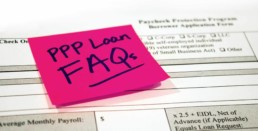Can I Include My PPP Loan In My Bankruptcy?
In response to the coronavirus pandemic, Congress passed the Coronavirus Aid, Relief, and Economic Security Act or CARES Act in March 2020. This law included a variety of different types of relief to individuals and small businesses, including the creation of the Paycheck Protection Program. Administered by the Small Business Administration, the PPP offered a lifeline to small businesses that struggled to meet payroll and other expense obligations. PPP loans offered businesses an avenue to continue operating and retain their employees as the economy fell.
PPP loans are fee-free, low-interest, and forgivable as long as the recipients meet specific requirements. The main requirement for PPP loans is to retain employees on payroll and use the money to meet payroll obligations, pay the business's utilities, pay rent, or pay mortgage interest. However, the primary purpose of PPP loan funds is to help businesses pay their employees so that fewer people will be laid off from their jobs.
While this program was meant to provide relief in the short-term, the pandemic has continued for more than a year. Many companies that received PPP loans and made good-faith efforts to retain employees have been forced to close or downsize. As a result, some small business owners are unsure if they qualify for loan forgiveness if they might be forced to repay their loans, or what options might be available to them for relief. Fortunately, small business owners who are unable to have their loans forgiven might still be able to have them discharged through bankruptcy.
Loan forgiveness requirements
To have your PPP loan forgiven, you will have to apply and meet specific requirements. If your small business does not have employees, a simplified application is available.
To qualify for loan forgiveness, you must meet the following requirements:
- Keep employees at the same pay rates during the qualifying period.
- Spend the funds on payroll and other eligible expenses.
- Spend a minimum of 60% of the proceeds on payroll expenses.
When you apply for loan forgiveness, you must be accurate and have documentation to back up what you claim. The government has recently taken a new look at PPP loan recipients because of reports of widespread fraud. Your PPP loan could be subject to a random check to ensure that you used the funds as intended.
If your business does not qualify to have your loan fully forgiven, you might still be eligible for partial loan forgiveness. For example, if you did not spend 60% of your PPP loan proceeds on payroll expenses, you might still receive partial forgiveness of your loan if you spent 60% of the forgiven amount on payroll costs.
Bankruptcy as an option for PPP loans
Bankruptcy might be an option for you if you cannot manage your PPP loan, depending on how your business is structured and whether you want to continue its operations.
Chapter 7 bankruptcy
In general, PPP loans can be discharged through Chapter 7 bankruptcy. However, what this might look like might differ based on how your company is organized. If you are a sole proprietor, you will have to file for personal bankruptcy. In this scenario, your PPP loan will be treated like your other unsecured debts. Since your personal assets and income will be important, you should talk to an experienced bankruptcy attorney at the Shulman Law Office before deciding to proceed under Chapter 7.
If your business is organized as a separate entity, your business can file for Chapter 7 bankruptcy. This will dissolve your business and cease its operations, however. If you plan to close your business, however, this can be a good way to end its operations and ensure that its debts are taken care of. Since PPP loans do not require personal guarantees, you should not have to worry about your personal assets being reached if your company files for bankruptcy under Chapter 7 as a separate entity.
However, if you received funders through the Economic Injury Disaster Loan program, the situation might be murkier. Some EIDL loans require personal guarantees and collateral. If your loan is secured, you will not be able to discharge it through bankruptcy without surrendering the property that is secured the loan. If you personally guaranteed the loan, your debt will not go away if you dissolve your company.
Chapter 13 or Chapter 11 bankruptcy
If you are a sole proprietor, you might be able to include your PPP loan in a Chapter 13 bankruptcy. This type of bankruptcy includes a repayment plan, allowing you more time to repay your debts. If your business is a separate entity, you could file for Chapter 11 bankruptcy if you want to continue its business operations.
Get help from the Shulman Law Office
Bankruptcy could provide a solution if you are unable to repay the unforgiven portion of your PPP loan. Before you file for bankruptcy, however, you should first take a look at the requirements for forgiving your loan.
If your loan cannot be forgiven, the Shulman Law Office in San Jose, California can help you to decide which type of bankruptcy might be the right option for you. We can review the different factors and help you to understand your rights. We understand the difficult circumstances that many people and business owners have found themselves in during the pandemic, and we are dedicated to helping you find the best solutions for resolving your debts. Contact us today to request a confidential consultation by calling us at 408-297-3333.


